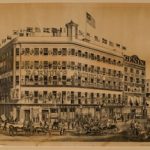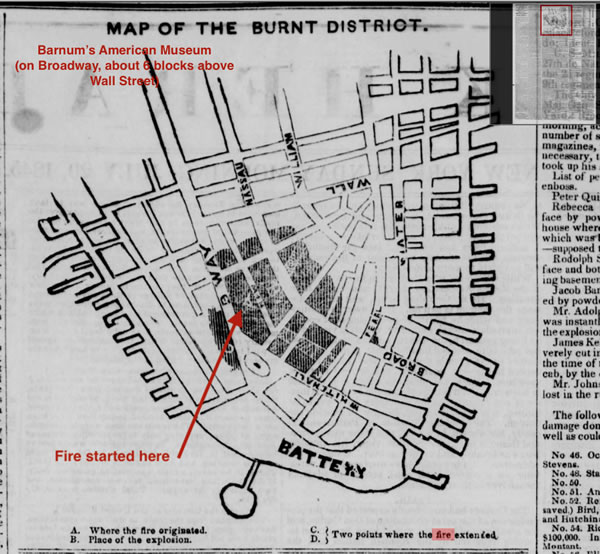"An Awful Great Fire in NY" (in 1845)

Last week we left Mr. Barnum with plans to take General Tom Thumb and his entourage to Spain, where he eagerly anticipated an audience with the Queen, as well as introductions to the Dukes and Duchesses who would be with Her Majesty in Pamplona. While they journey forth, we will turn back to probe some other facets of Barnum letters in the July – August 1845 time frame we’ve thus far been exploring. I’ve found some tantalizing comments that bear investigation—especially those concerning Barnum’s American Museum and the state of things in New York City that summer. To contextualize the brief yet “curious” references in Barnum’s communications with his business associates, I consulted New York newspapers of the same period to find out what was going on. (Visit the Library of Congress’s online newspaper database, Chronicling America.)
On a couple of occasions Barnum mentioned the idea of purchasing “Peale’s collection” as a back-up, in case the American Museum’s collection was consumed in a fire. What exactly did he mean by that? We need to unpack a couple of things here: Peale’s collection, and the threat of fire.
You may be familiar with the legacy of Philadelphia painter Charles Willson Peale’s artistically-gifted family, and that two of his sons followed in their father’s footsteps by also opening museums devoted to art and science in New York and Baltimore. Rubens Peale’s New York museum opened in 1825 but began to founder after the Panic of 1837, and a few years later was taken over by bank directors. The story of that museum’s demise gets complicated; Barnum ultimately leverages a weakened competitor to drive traffic to his own museum. Suffice it to say that in 1845, when Barnum was floating the idea of purchasing another collection in case of the loss of his own, he was already the owner of “Rubens Peale’s” museum collection, which he had brought to the American Museum in early 1843. So was Barnum now expressing interest in the more famous, elder Peale’s Philadelphia Museum collection, or that of Rubens’ brother Rembrandt in Baltimore? Most likely he meant the latter, since it was between 1845 and 1846 that Barnum leased the Baltimore museum and may have acquired at least a portion of its collections. However, the former idea was not out of sight!
In regard to the concerns about fire, my curiosity was piqued about the timing of the proposed back-up plan, knowing as we do now that the American Museum did burn to the ground, though a full twenty years later. Was this typical thinking, that a fire was inevitable, and he best be prepared to get back in business quickly? Writing to showman-friend Moses Kimball in Boston on August 26th, Barnum confided, “I am half glad that you will not want Peale’s. I ought to buy it, for if the American [Museum] should burn down, I could not get Peale’s probably short of $10,000 or $15,000 to replace my stock.”
As it turns out, fire was very much on people’s minds in New York City in the summer of 1845, as a catastrophic event took place early in the morning of July 19th. On August 19th Barnum wrote to an unnamed correspondent, “There has been an awful great fire in N. Y. Luckily it did not quite reach my Museum.” (Bear in mind, Barnum may have only just received that news, since he was dependent on letters and newspapers coming to him across the Atlantic via steamer, and then reaching him by mail coach.)
This was no ordinary fire in an era when fires were relatively commonplace. The New York Herald published an “EXTRA” on July 20, 1845 to describe in vivid detail what happened and estimate the losses, such as were known at that moment. “The greatest, most terrible fire that has occurred in this city since the great conflagration of December, 1835, has spread devastation through-out the lower part of the city.” The losses were calculated to be between $5 and $10 million, a staggering amount at that time.

According to the Herald, it appeared that the fire had broken out in a sperm oil store, then spread to a chair factory. Like a hungry dragon, the flames spread quickly and consumed everything in their path. In very short order, the situation escalated to something far worse. According to the report, the fire was fueled by saltpeter (potassium nitrate)—or more likely some other more combustible materials that had been illegally stored in buildings—which set off massive explosions. The first building to blow up carried six or seven other buildings with it and “[shook] the whole city like an earthquake. The concussion was so great as to smash more than half a million panes of glass in the neighborhood, to the extent of 200 yards distant.”
Across the East River, in Brooklyn, “many of the inhabitants felt their houses rock to the very foundation . . . . Some say that the spire of Trinity [Church] shook for nearly a minute after the explosion . . . .” It was reported that one of two explosions near the start was caused by a “reservoir of gas in New street.” Upon “the bursting of the reservoir, the whole air was filled with a mass of living flame, which in a few instants attached itself in various places to the surrounding buildings, and from this circumstance, mainly, it was that the fire extended itself with so much rapidity . . . .” To add to the chaos, a fire engine had to be abandoned when it was buried by a fallen wall, its crew narrowly escaping. As spectators gathered, many people were injured or killed as a consequence of the fire’s wild unpredictability, and the explosions, with falling bricks and entire walls. In addition, furniture and trunks being thrown from upper story windows in an effort to salvage possessions threatened the safety of people below.
The tragedy and wreckage wrought by the fire was extreme. The Burnt District, as the Herald called it on their map sketch, covered the better part of about 12 blocks in lower Manhattan, above the Battery and extending up to Wall Street. The area was described as a blackened desert, so complete was the devastation. As Barnum noted to his correspondent, his museum had escaped damage, being six blocks further up Broadway at the corner of Ann Street. But it was a close call, and this came as sobering news. Little could Barnum know at that point in his life how many times calamitous fires would come to affect his own life and fortunes, and that his own museum would burn not just once, but twice. An ironic twist to this story is that a few years after these letters, around 1850, Barnum and Moses Kimball purchased the Peale collection in Philadelphia, and Barnum opened a museum there only to lose it to fire the following year. Indeed, he had good reason to be concerned about fires, and would face more in the future.
Next week we will pluck ourselves from the ashes and learn about the attractions Barnum was seeking to purchase in Europe in the hopes of drawing ever-larger crowds to his American Museum.
Adrienne Saint-Pierre,
Barnum Museum Curator

